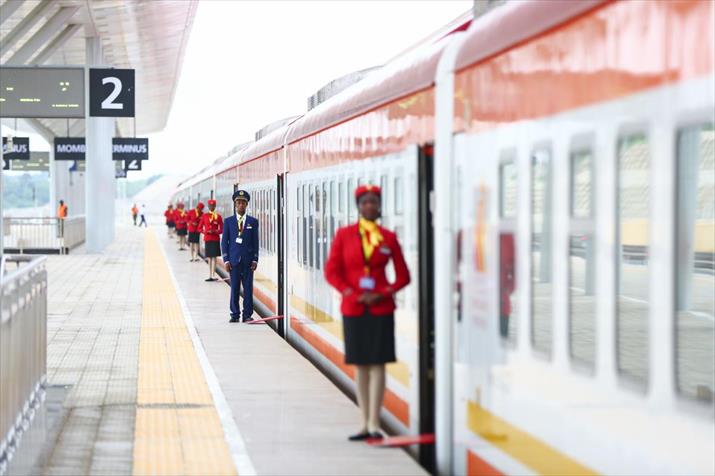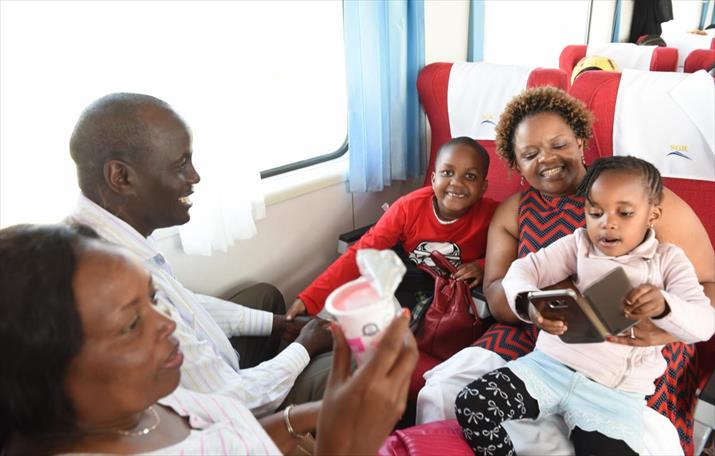|
||||||||||
| Home Nation World Business Opinion Lifestyle ChinAfrica Multimedia Columnists Documents Special Reports |
|
||||||||||
| Home Nation World Business Opinion Lifestyle ChinAfrica Multimedia Columnists Documents Special Reports |
| Africa |
| Riding Kenya's New Train Line |
| The recently completed Mombasa-Nairobi railway brings a new era of train travel in Kenya |
| By Hannah Ryder | VOL.9 September 2017 ·2017-09-05 |

As a small child growing up in the Kenyan capital Nairobi, our annual family holiday to the beautiful beaches of Mombasa always began and ended with a degree of trepidation.
My sister and I would jump into the car and during the journey along the then notoriously treacherous single-lane highway, we would pass the time either by waving at other drivers or playing "count the potholes." By the time I was old enough to drive the route myself, the government had received funds from the World Bank and European Union to extend much of the road into a dual carriageway and filled in many of the dangerous potholes, saving precious lives.
A similar change has recently taken place on Kenya's railway, which follows the same route from Nairobi to Mombasa, and has now been upgraded, this time, by a Chinese company.
Colonial memories
The last time I traveled that train route was with my husband, during his first visit to Kenya. I was keen to impress him. Taking an old sleeper train on a track built between 1896 and 1901 by British colonialists seemed like a romantic option compared to a one-hour flight or an all-night coach.
The train operators tried their best to recreate those old colonial days - with fresh white sheets and crisp blankets in the berths and delicious eggs and toast for breakfast in the restaurant car. But try as they might, the train itself was old and rickety. Something else the operators could not prevent or foresee was a seven-hour delay thanks to an elephant on the track. We were therefore relieved to learn at that time that South Africa and Turkey were considering investing in the route and hoped it would happen soon.
Unfortunately, those investments never materialized. But what did happen was a tender issued by the government in 2013 for improving the route. The government decided it was high time to slash the travel time between Nairobi and Mombasa to just four hours by train - for both passengers and freight - thereby increasing tourism and trade. The plan also sought to cut down on the number of trucks and cars using the highway. It was a vision for greener growth, answered in the end by $3.8 billion in Chinese funding.

Affordable fares
Fast forward to the recent opening of the line. Some commentators, both in Kenya and abroad, have lamented that the project costs are too high, especially compared to other new railways elsewhere in the world. Others have justified the cost on the basis that the railway incorporates several bespoke modifications; for instance, extra bridges to avoid damaging or displacing traditional wildlife routes. That's the elephant problem solved I guess!
But one indicator of cost effectiveness is to compare the new passenger fares with the old ones. A first-class ticket now costs around $30, with an economy ride costing just $9, comparable to the price of an all-night coach ticket. At these prices, more than 75,000 ordinary Kenyans, including my cousins, have already taken day trips using the train, taking proud selfies in the comfortable new seats.
Challenges
The volume of debt that Kenya is taking on to finance the new railway route is a major concern for many commentators, who are cautious about future extensions planned that will eventually link to other land-locked countries on the African continent such as Uganda and Rwanda. What they fail to mention is that in terms of the ratio of public debt to GDP, according to World Economic Forum statistics, Kenya ranks No.77, with a more sustainable ratio than many European countries, such as the UK and Germany. Not to mention that the IMF forecasts that Kenya will grow at 6 percent in 2017, a little slower than China and its neighbor Ethiopia, but nevertheless considerably faster than the United States and Europe as a whole. My Ugandan and Rwandan friends simply cannot wait for the new tracks to their countries to be completed.
That said, it hasn't all been plain sailing for Kenya's new railway and I can't imagine that it will be a completely smooth ride going forward. There have been major disputes about the number of Kenyans that have been employed to build the railway, and the effectiveness of arrangements for quality maintenance of the railway will need to be consistently monitored. Thankfully, Kenya has a very open culture and a thriving society, so any issues will come to the fore quickly giving the government and its Chinese partners the opportunity to resolve challenges without delay.
For now, I'm excited about this new upgrade and I can't wait to visit Kenya and join others in my debut journey along the scenic route, in comfort rather than in fear, although hopefully without the elephants!
(The writer is a Kenyan-British diplomat, economist and writer)
|
||
| About Us | Contact Us | Advertise with Us | Subscribe |
| Copyright Beijing Review All rights reserved 京ICP备08005356号-5 京公网安备110102005860号 |